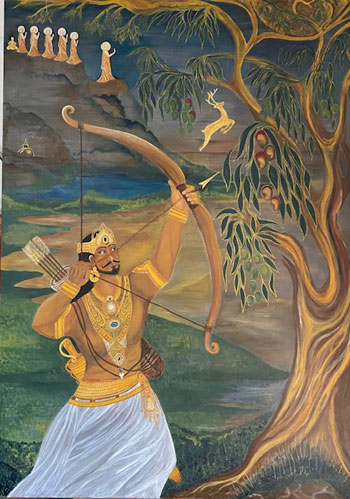A day of profound significance
According to Buddhist chronicles, the Buddha visited Sri Lanka on three occasions, to Mahiyangana, Nagadipa and Kelaniya. The visits were to mediate between two tribes – the Yakkas and Nagas – and in Kelaniya to settle a dispute between two regional Naga Kings, Mahodara and Chulodara.
Although the Buddha used the Dhamma to settle the disputes, it was not established in the country at that time. The Buddha’s visits were aimed only at resolving disputes to give solace and inner peace and settle differences between the two tribes.

King Tissa on a hunting expedition when he sees Arahant Mahinda on the Missaka rock in Mihintale on a Poson Poya - A painting by Avanti Karunaratna
In India, Emperor Ashoka after witnessing the vast destruction and suffering during the Kalinga war, embraced Buddhism and decided to promote non-violence and compassion. He also resolved to propagate the Buddha Dhamma in other lands. This was after the 3rd Dhamma Sangayana (Buddhist Council) which was convened to resolve disputes regarding the Dhamma and to correctly establish the Theravada teachings of the Buddha’s teachings.
According to historical accounts, the Emperor was a friend of King Tissa of Sri Lanka though they had never met. Their friendship grew with the exchange of gifts and messages. Emperor Ashoka had informed King Tissa that he had converted to Buddhism to follow a path of non-violence and compassion, and inspired the king also to do so. With the belief that the King might be receptive to Buddhism, he decided to send his son Arahant Mahinda Thera to Sri Lanka.
After the third Dhamma Sangayana, Emperor Ashoka focused on adhering to the correct Theravada teachings of the Buddha, and planned to send emissaries to nine foreign lands to spread the Buddha Dhamma.
The arrival of Arahant Mahinda Thera in the 3rd Century BC, on a Poson Full Moon Poya is indeed significant for Sri Lanka, especially for Buddhists.
Arahant Mahinda Thera arrived in the country with four bhikkhus (monks) –Ittiya, Uttiya, Sambala, Buddhasala and two relatives, Sumana samanera (novice) and upasaka (layman) Bandhuka. They stood on the Missaka rock in Mihintale, observing King Tissa who was on a hunting expedition chasing a deer. The King stopped in his tracks as he heard his name being called for no one would dare address the king by his name. Looking up, he saw a serene figure in yellow robes. He laid down his bow and arrow and moved closer to the Missaka rock to listen to what the Arahant had to say, which ended in a long and fruitful discussion.
Arahant Mahinda informed the king that his father Emperor Ashoka had sent him to deliver the message of the Buddha Dhamma. But first the Arahant decided to test the king’s intelligence to ensure that he would be able to comprehend the profound Dhamma. The King was standing near a mango tree and taking this as an example, the Arahant posed a question which is known as the Amba prashnaya (the mango riddle) to which the king answered intelligently. The second question was the ñathi (relatives) question. This too was answered correctly, making the Arahant decide that the King was intelligent and capable of understanding the profound Dhamma and doctrine.
Thereafter the Cullahatthipadopama Sutta was explained to the king. This sutta with the simile of the elephant footprint was first explained by the Buddha to Janussoni, a Brahmin, who resolved to follow the teachings of the Buddha Dhamma. It provides guidance to monks on how they should conduct themselves and strive to become Arahants, understanding the Four Noble Truths – dukka ariya sacca (suffering), dukka samudaya ariya sacca (the cause of suffering), dukkka niroda ariya sacca (cessation of suffering) and dukka nirodhagamini patipada ariya sacca (path leading to the cessation of suffering) and the ariya atthangika magga (Noble Eightfold Path).
Arahant Mahinda’s intention was to make the king aware of the disciplined life a monk should lead and the principles of the Buddha Dhamma. The King who listened with rapt attention and great faith informed him that he wished to embrace the Triple Gem – Buddha, Dhamma and Sangha.
When Arahant Mahinda arrived in the island, people believed that there were gods in trees, rocks, fire, sun and the moon and worshipped these natural elements and phenomena as sacred and divine. They feared that if they did not do so they would face the wrath of the gods.
The King’s decision to embrace a new faith had a significant impact on his subjects. The social and cultural fabric of the country changed. The system of worship also changed. Arahant Mahinda gradually introduced the worship of the Bodhi tree, lighting of oil lamps, Buddha images, viharas, dagabas and chaityas. The people became accustomed to it and also found refuge in the Triple Gem – Buddha, Dhamma and Sangha.
The arrival of Arahant Mahinda is also important, as it was on his initiation his sister Arahant Sangamitta Theri arrived to establish the Bhikkhuni Sasana (order of nuns) in the country. She arrived with a sapling from the Jaya Sri Maha Bodhi from Gaya as a gift from Emperor Ashoka to King Devanampiyatissa to be planted at Anuradhapura.
The upasampada ceremony, the higher ordination of bhikkhus (monks) and bhikkhunis (nuns) was introduced by Arahant Mahinda Thera. This allowed a large Sangha (fraternity of monks and nuns) to be ordained in the country. It is mentioned that King Uttiya who reigned after King Devanampiyatissa built the Mahinda Seya(stupa) in Mihintale to enshrine the Arahant’s relics.
The upasampada ceremonies which began with Vesak Full Moon Poya in May this year will end on June 10 – Poson Full Moon Poya. On this day, thousands of Buddhist devotees will visit the Mahinda Seya in Mihintale where that first historic sermon is said to have been delivered.
Searching for an ideal partner? Find your soul mate on Hitad.lk, Sri Lanka's favourite marriage proposals page. With Hitad.lk matrimonial advertisements you have access to thousands of ads from potential suitors who are looking for someone just like you.


